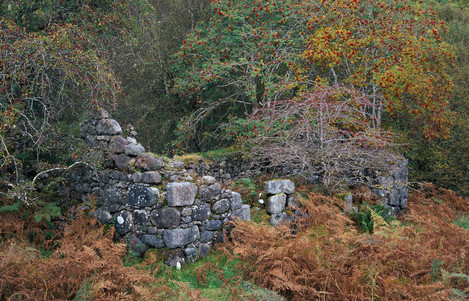Majestic Kings of the Hills

Tim Parkin
Amateur Photographer who plays with big cameras and film when in between digital photographs.
The Rowan or Mountain Ash (also known as Quickbeam and Rowan Berry) is, intriguingly, a member of the Rose family along with Hawthorns, the Whitebeam and the Service Tree. Most fruit trees and shrubs are also in the Rose family, close enough that there are crosses that bear fruit. One cross between a Mountain Ash and a Pear is called the Shipova (other fruit tree and shrubs in the family are apples, quinces, apricots, plums, cherries, peaches and oddly raspberries, loquats and strawberries). It is most definitely not an Ash, though, and fortunately is also not susceptible to Ash die back (Phew!).
The Rowan (as it is most commonly known in the UK) is most distinctive in its leaves. The Rowan has a compound, pinnate (feather-like) leaf that splits into six to eight pairs of leaflets with a single leaflet at the end and each leaflet is toothed. The leaves are hairless and dark green above grey-green underneath. This can lead to the mountain ash ‘glittering’ in the light in a similar way to Birch.
It is an incredibly hardy tree and can be found all over mountain areas of Europe from Northern Spain and Italy upwards (excluding southern Spain and Greece) and well into the Arctic Circle. Variations of the Rowan also inhabit most of Russia and Asia and spread by humans into North Eastern America.
The Rowan is an apomictic (google “apomixis”) species which means that it can reproduce hermaphroditically which produces clones of the parent plant. This can cause very odd microspecies to continue propagation i.e. two different Rowan species breed normally and produce a mutated child tree. This child tree can then clone itself repeatedly. This leads to quite varied ecosystem of microspecies of Rowan, making detailed identification quite difficult. We’ll be talking mostly about Sorbus Aucuparia subspecies Aucuparia here though.
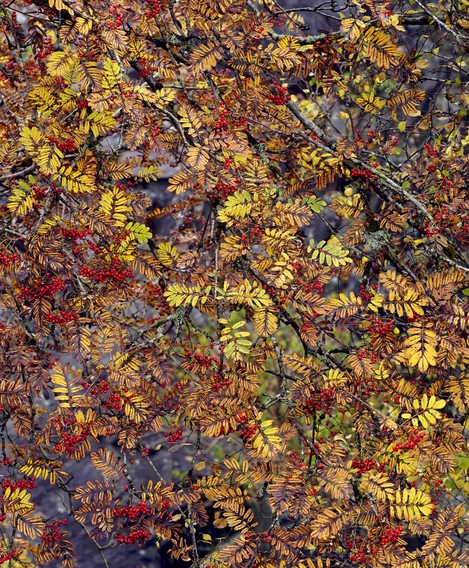
Autumn Jewels, Glyn Rhonwy, Richard Childs, website
It can be found higher up on mountainsides than any other tree in Britain and is often seen above the usual tree line hanging to rocky outcrops or scree slopes or on open heathland. The reason for this seems to be that the roots need to be ‘aerated’ and so they don’t grow well in wet conditions. Because of this, they do not like very dry conditions either.
They rarely form stands of trees and are most commonly found in isolation. However, because of their ease of self-fertilisation and widespread dispersal by berry-eating birds, you can usually find the occasional sapling, even under tree cover. These rarely form into large trees.
The trees themselves grow up to 30ft but some examples reach up to about 80ft (in the Chilterns for instance). The largest examples may grow up to one hundred years old but once the main trunk becomes infested with fungi it dies and then ‘stool’ shoots. In this way the tree can keep growing for hundreds or even up to a thousand years.
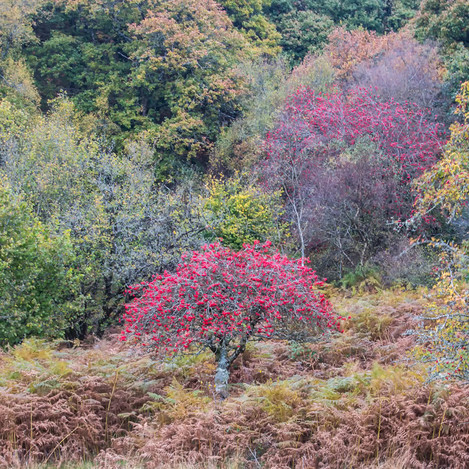
Alone, Dartmoor, Christian Schoter, Facebook
The latin name ‘Aucuparia’ means bird catching because a mixture of the berries and other ingredients was used to make a sticky substance for catching songbirds for food. The substance was also used to make sticky bombs in the war (but failed as it wouldn’t stick to dusty, muddy tanks).
If food for birds is scarce in Scandinavia, many birds such as Waxwing, Redwing and Fieldfare will migrate to the UK to feed on our berry crop.
The berries are edible to humans and are rich in vitamin C, but people should be careful of eating it raw in large quantities as it contains para sorbic acid, which is toxic. Cooking breaks down it down and renders the berries harmless.
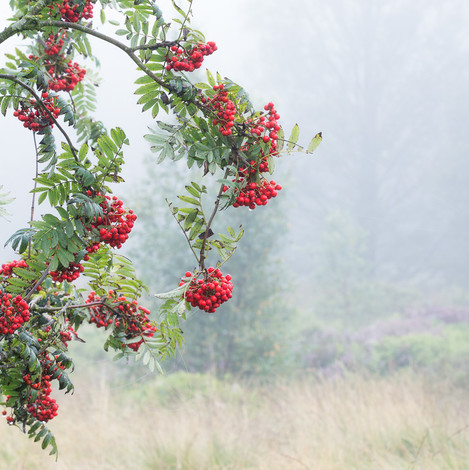
Late Summer Fog, Norland Moor, Calderdale, Yorkshire, Robert Birkby, website
Folklore
The Rowan is a prominent tree in folklore across the whole of Europe. In Greek legend, the birth of the Rowan came about because of Hebe (Zeus’s daughter) and Hera (The goddess of youth who could make a drink that restored youth). Hera was supposed to bring drinks to the Hebe but she let the cup be stolen by demons. The gods sent an eagle to recover the cup and in the battle, wherever a drop of blood or an eagle's feather hit the ground, a Rowan grew (hence the feathery leaves and red berries).
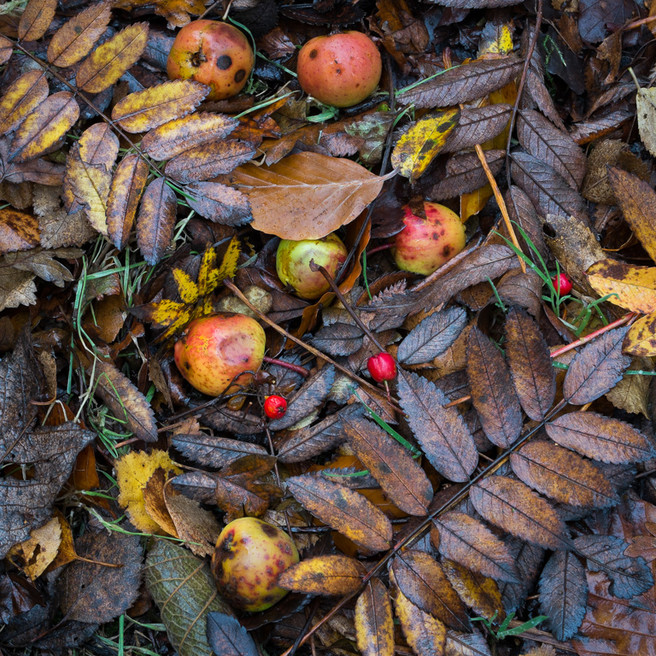
Windfall, Keil's Den, Largo, Fife, Andy Latham, website
It is thought that the Norse myth of the frost dressed Rowan tree in moonlight, celebrated at winter solstice, gave birth to the Christmas tree. The myths even talk of a special star that twinkled at the top of the tree.
It has a life-saving mythology in Scandinavia too, where Thor was rescued from a set of rapids by an overhanging Rowan. In Scandinavian myth the Rowan gave birth to the first woman (as Ash gave birth to the first man).
Rowans have also been historically associated with mythical beasts such as dragons or serpents, a counterpoint to its powers as the ‘tree of life’ in most countries mythologies.
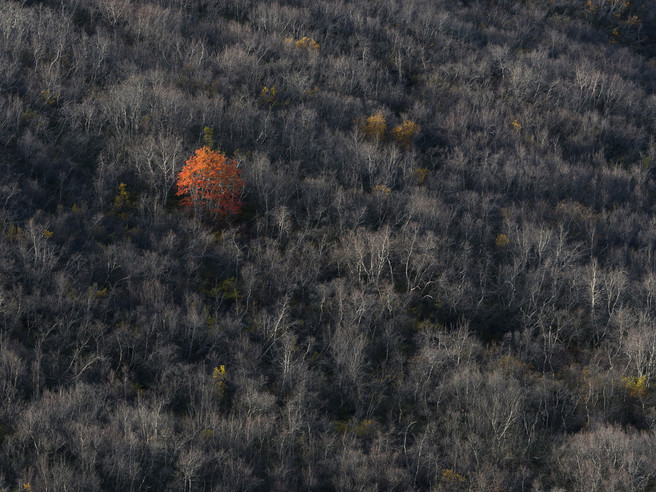
Late splendour, Búðardalur, Iceland, Gerard Oostermeijer, Website
In Irish mythology the Rowan was associated with the artistic (usually musical) Muse, probably to do with its popularity with songbirds.
In Scottish myths the Rowan was protective against evil spirits and is also known as the wayfarer’s or traveller’s tree. People are warned not to cut down a Rowan tree on their property for fear of bad luck.
Photographing Rowan Trees
From the first Sprigs of bright green in April, white blossom in May, through autumn colour and red berries that can stay on the tree up to December, the Rowan offers a range of opportunities visually.
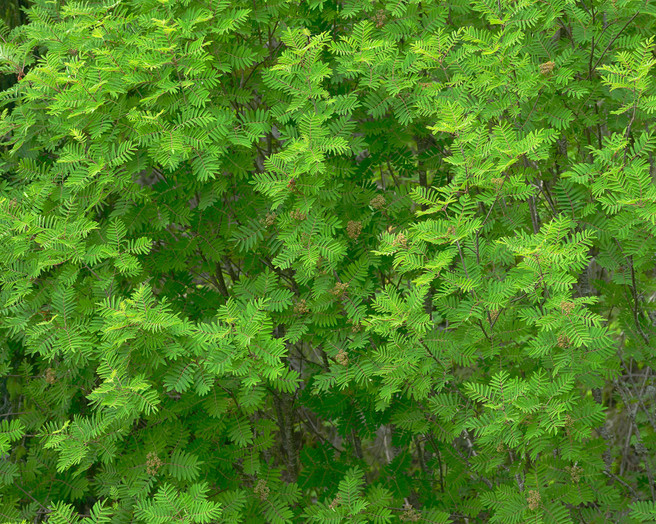
Count the leaves... to sleep Parang Mountains, Romania by Serban Simbotelecan, website
The early blossom is not often photographed but in a good year the profusion of creamy flowers against the fresh green is a treat at the start of spring.
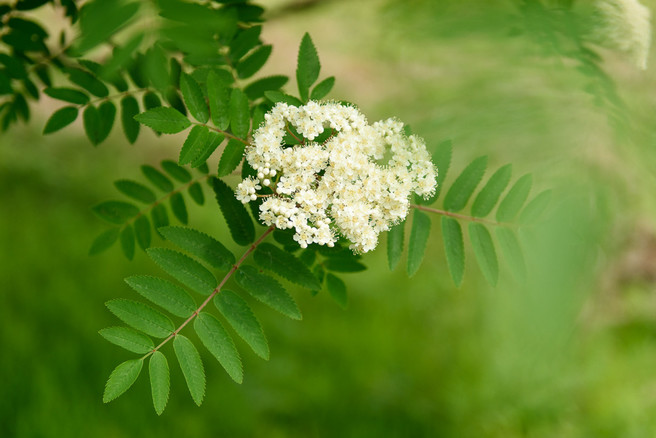
Durham, Guy Richardson, Website
But for most people the fun with Rowan really starts with the appearance of its first berries around July.
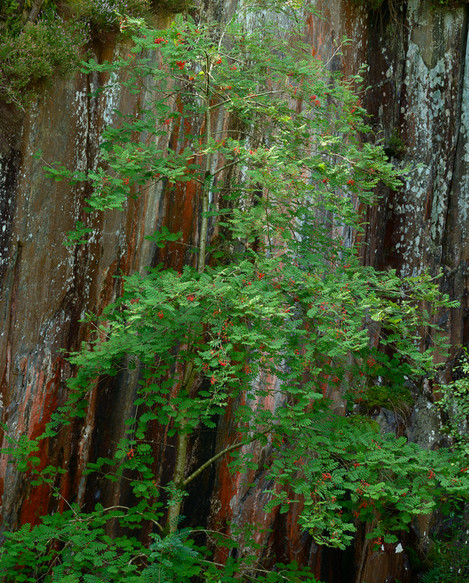
Dalt Quarry, Rowan Dalt Quarry, Borrowdale, August 2015, David Fearn, Flickr
As can be seen above in David Fearn's image, the Rowan's propensity to grow in unisual places can be used to great effect (have a look around quarries for them)
The highlight of the calendar for many people is when the berries are at their peak and the colour of the leaves starts shifting to oranges and yellows.
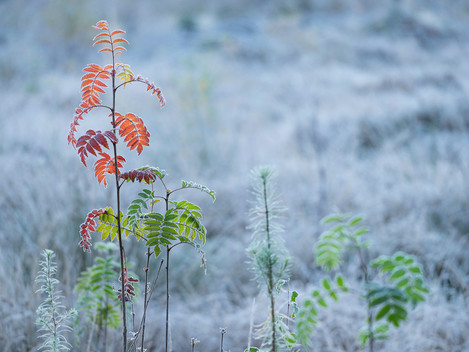
First Frost, Lower Glen Affric, Scottish Highlands, Nick McLaren, Website
Rowan are a little unpredictable though - sometimes they have no berries and sometimes the leaves skip to a burnt yellow (either sun damage or poor conditions).
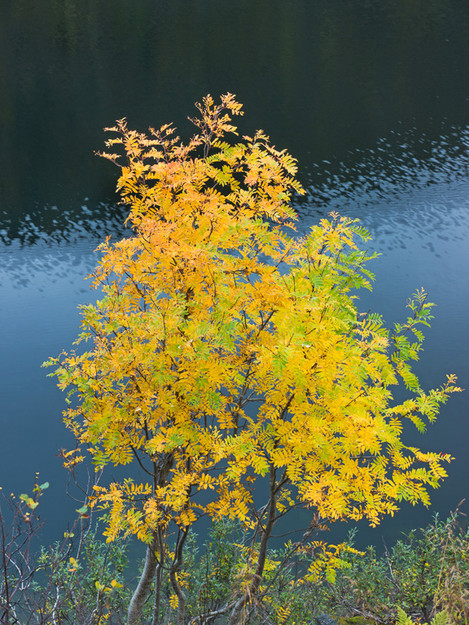
Mountain Ash, Kvaloya, Norway, Growing on the banks of a lake lower down, the leaves of this tree contrast beautifully with the dark blue waters, Adam Pierzchala, website
The leaves of the Rowan tend to fall quite quickly however and often you end up with a leafless tree covered in berries.
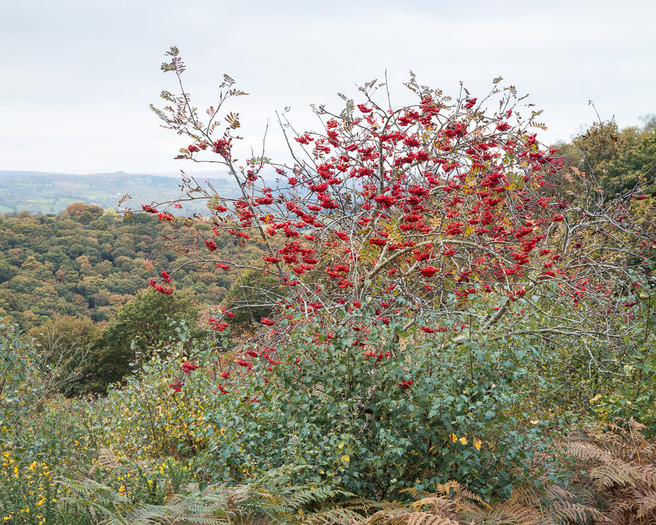
Rowan berries, Hunter's Path, Above the Teign Valley, Eastern Dartmoor, Terry Hurt, website
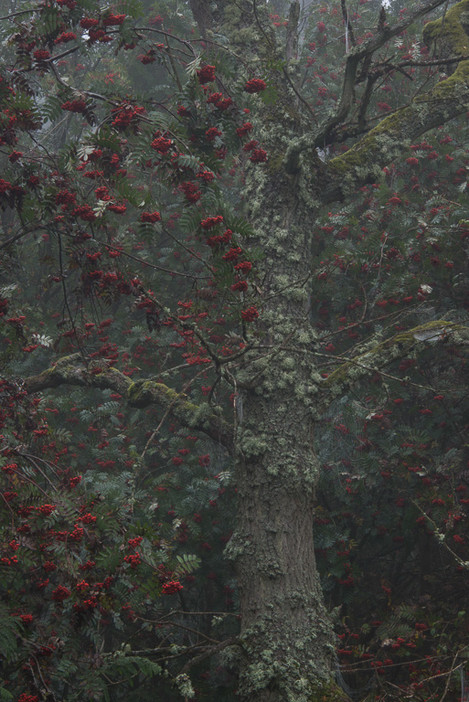
Bowdown Woods, Bowdown Woods, Berkshire, Rob Oliver, Website
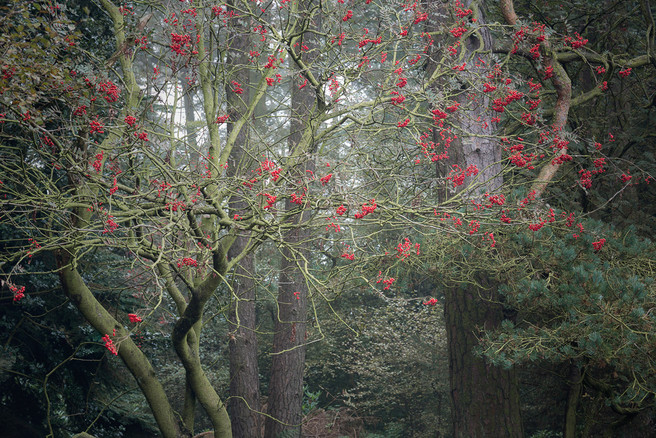
Twisted Rowan, Snilesworth, North Yorkshire Moors, Geoff Kell, Flickr
But if you're a bit crafty you can borrow some colour from trees behind your Rowan such as Birch or Beech.
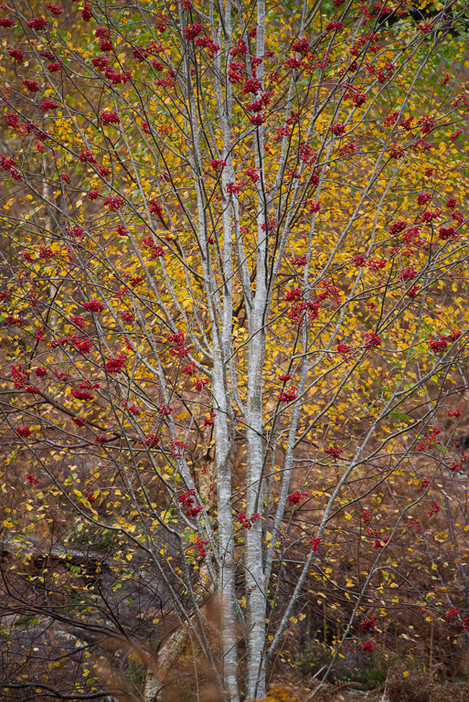
Rowan Berry Yellow, Snowdonia, Flickr
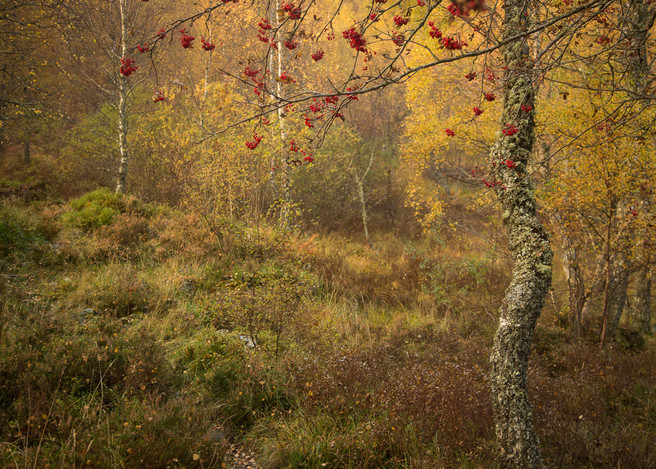
The Colours of Autumn Craigellachie National Nature Reserve - Aviemore, Scotland by Phil Johnson, website
It's not all over for those leaves though, once they have fallen they sit like feathers on the forest floor (look out for these on frosty days).

Windfall, Keil's Den, Largo, Fife, Andy Latham, website
Although the Rowan trunks and bark don't have the exquisite beauty of our Birches, their bowing branches can still make evocative shapes over winter.
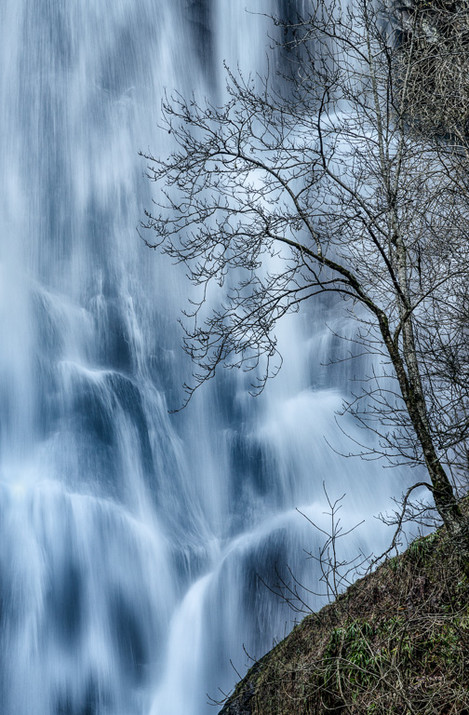
Cascades, Pistyll Rhaeadr, Alan Ranger, website
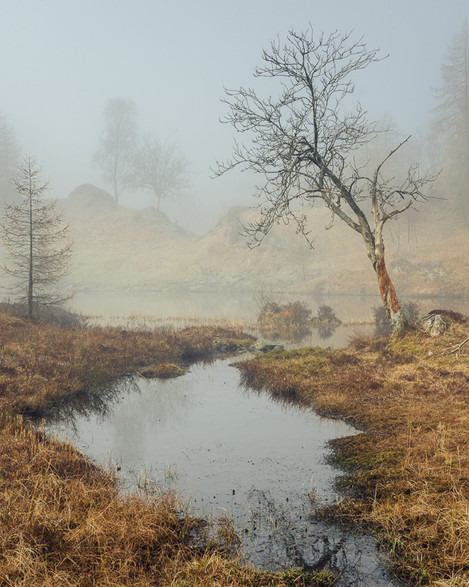
Twisted Rowan III, Holme Fell Tarn, Colin Bell, Website
Thank you all for your contributions again this issue - it's been a pleasure going through them all and we've included everyone in the gallery below. If you find any examples after reading this we'd love to see them so tag us on our Facebook or Twitter accounts.
- Rowan berries, Hunter’s Path, Above the Teign Valley, Eastern Dartmoor, Terry Hurt, website
- Rowan leaves in Autumn, Tandle Hill Park, Oldham, Paul Adams, website
- Berries & Bark Loch Hourn, Knoydart, Scotland, Harvey Lloyd-Thomas, website
- Rowan Berry Yellow, Snowdonia, Flickr
- Dalt Quarry, Rowan Dalt Quarry, Borrowdale, August 2015, David Fearn, Flickr
- Bowdown Woods, Bowdown Woods, Berkshire, Rob Oliver, Website
- Mountain Ash, Kvaloya, Norway, Growing on the banks of a lake lower down, the leaves of this tree contrast beautifully with the dark blue waters, Adam Pierzchala, website
- Cascades, Pistyll Rhaeadr, Alan Ranger, website
- Twisted Rowan III, Holme Fell Tarn, Colin Bell, Website
- First Frost, Lower Glen Affric, Scottish Highlands, Nick McLaren, Website
- Late Summer Fog, Norland Moor, Calderdale, Yorkshire, Robert Birkby, website
- Rowan Leaves, Tarn Hows, Lake District, Paul Moon, Website
- Durham, Guy Richardson, Website
- Late splendour, Búðardalur, Iceland, Gerard Oostermeijer, Website
- Twisted Rowan, Snilesworth, North Yorkshire Moors, Geoff Kell, Flickr
- Autumn Leaves, Lynchmere Common, West Sussex, Elke Epp, Facebook
- Rowan, Burnham Beeches, Buckinghamshire, Damian Ward, website
- Alone, Dartmoor, Christian Schoter, Facebook
- Windfall, Keil’s Den, Largo, Fife, Andy Latham, website
- Earth is my Home, Monaulty Wood Powys, Wales, Lesley Treloar, website
- Three Rowans, Wasdale Cumbria on the ascent to Sca Fell, Stephan Brzozowski, website
- Count the leaves… to sleep Parang Mountains, Romania by Serban Simbotelecan, website
- The Colours of Autumn Craigellachie National Nature Reserve – Aviemore, Scotland by Phil Johnson, website
- Fallen rowan berries on the moss polytrichum commune, Crowle Moor, Lincolnshire by Peter Roworth, website
- Sheepstor Rowan, Sheepstor, Dartmoor, Devon by Alan Howe, website
- Autumn Jewels, Glyn Rhonwy, Richard Childs, website


